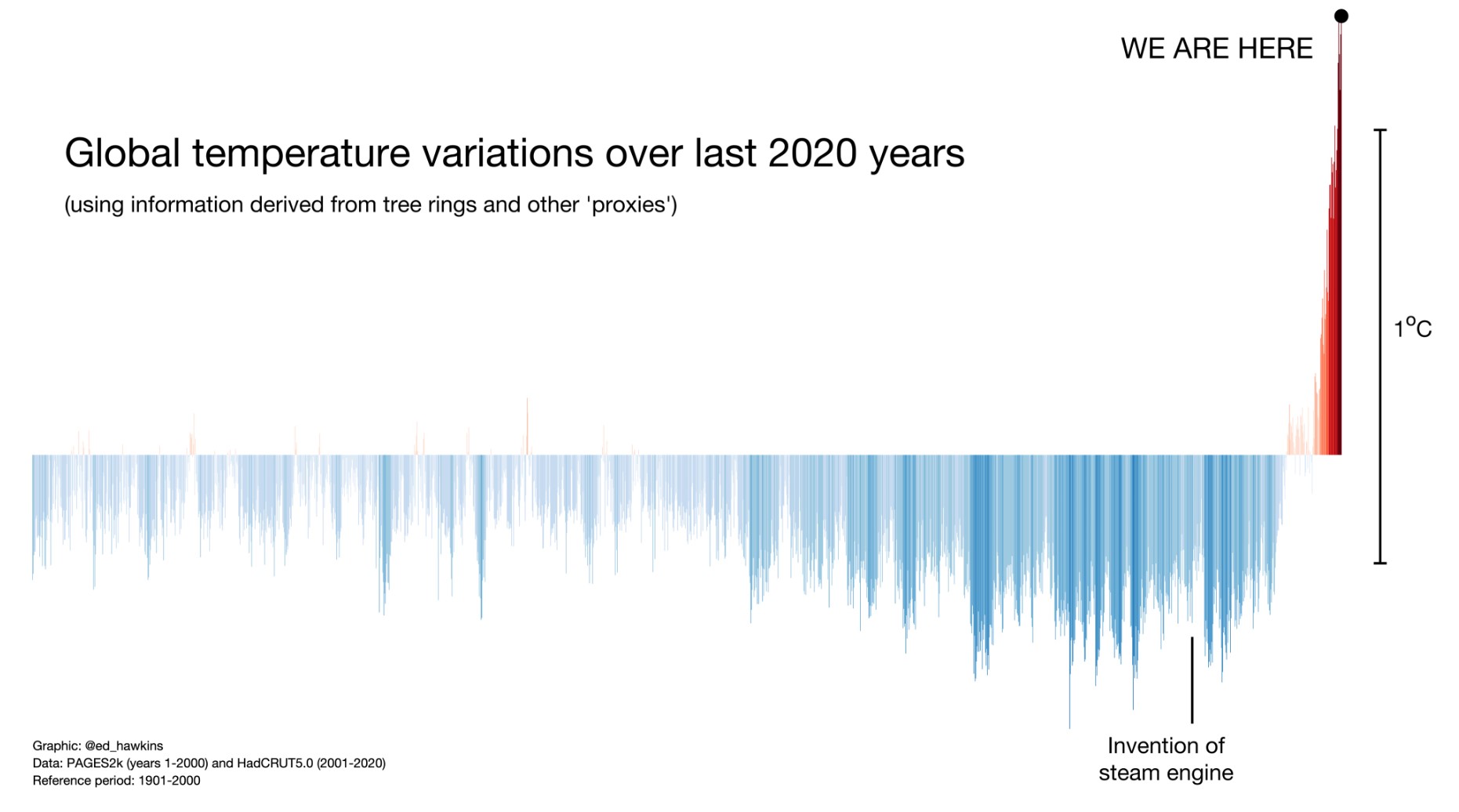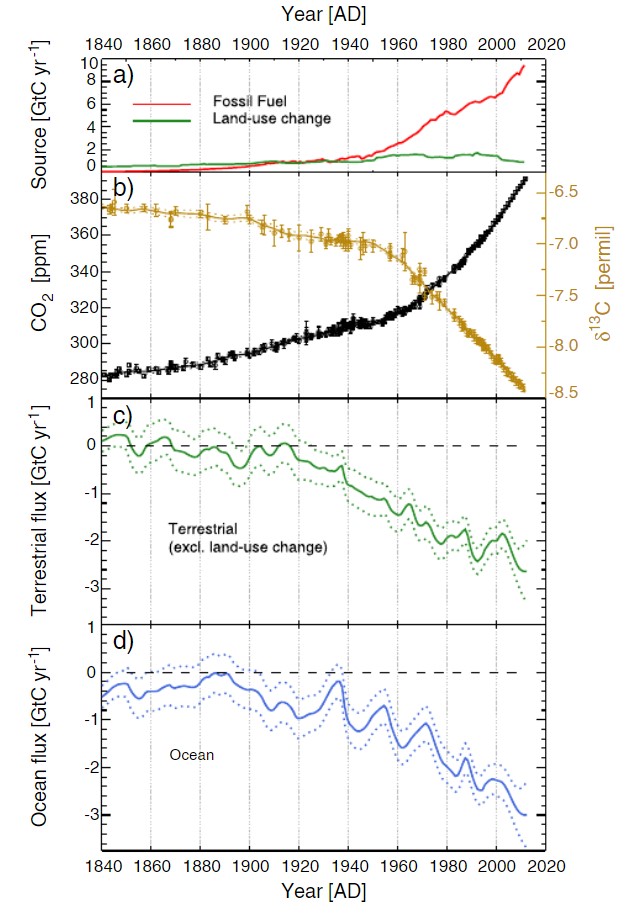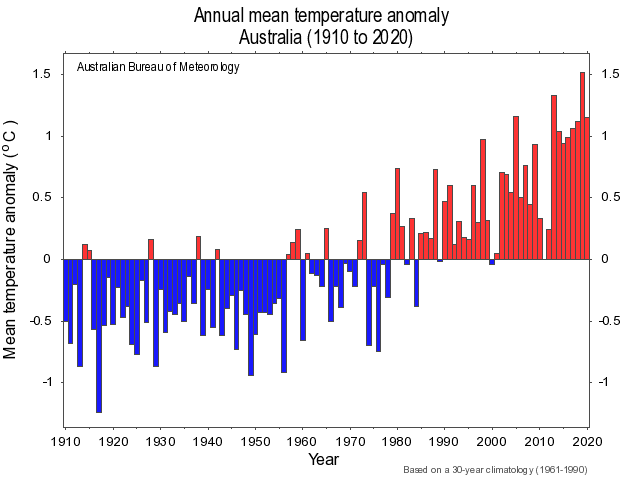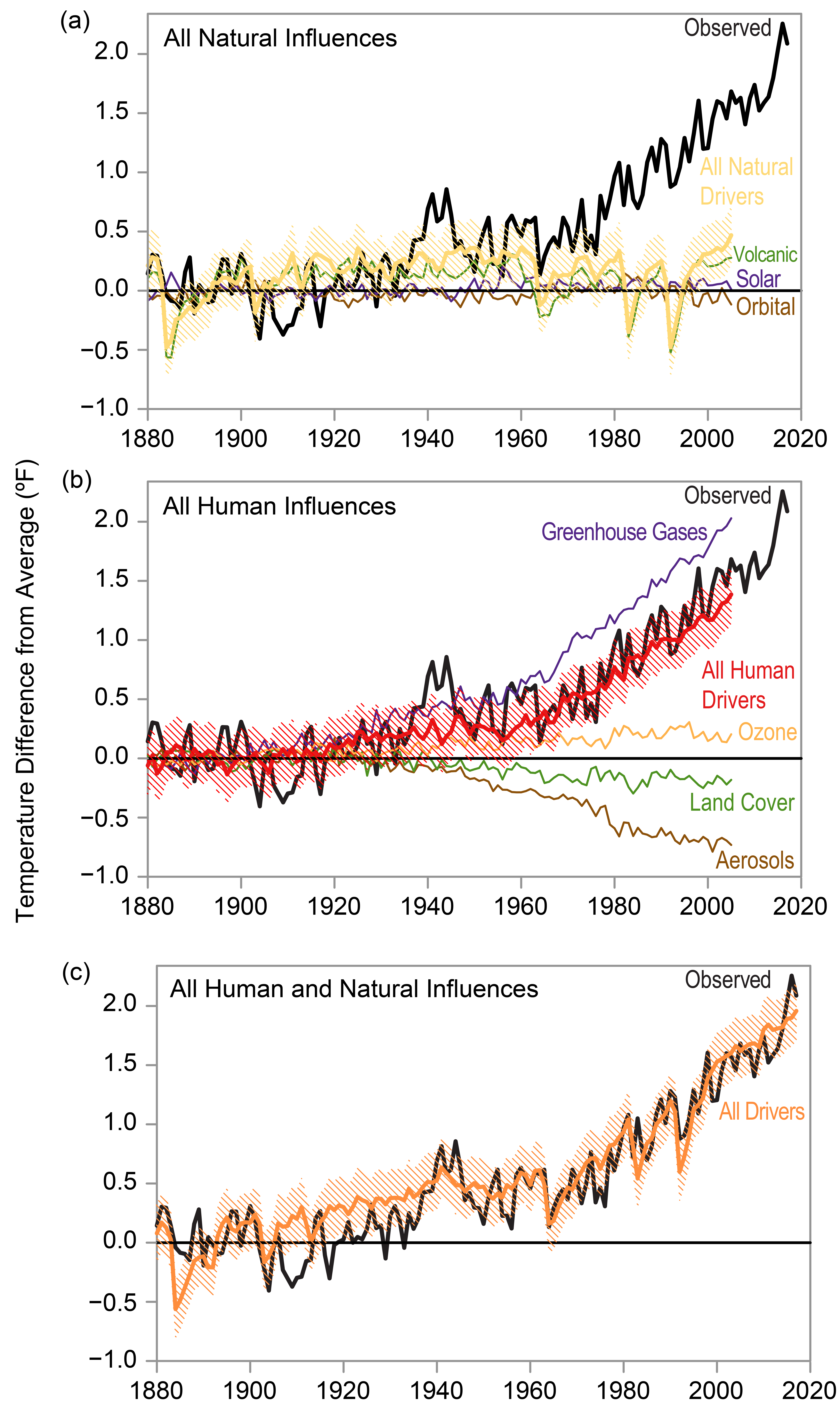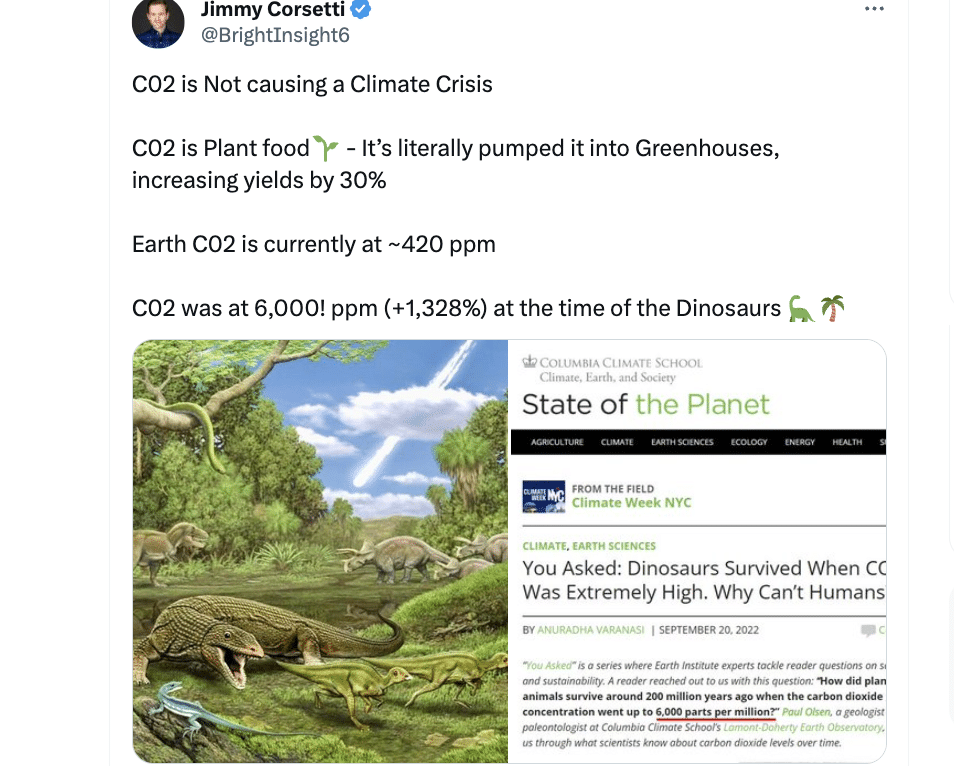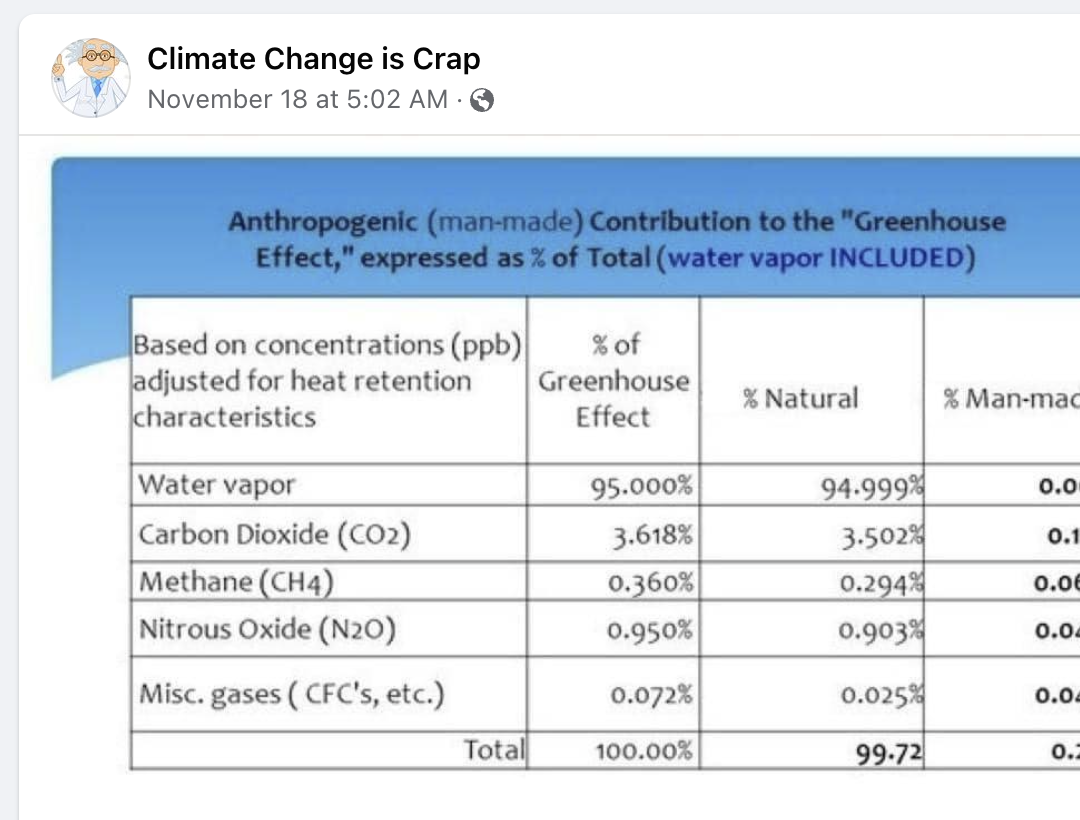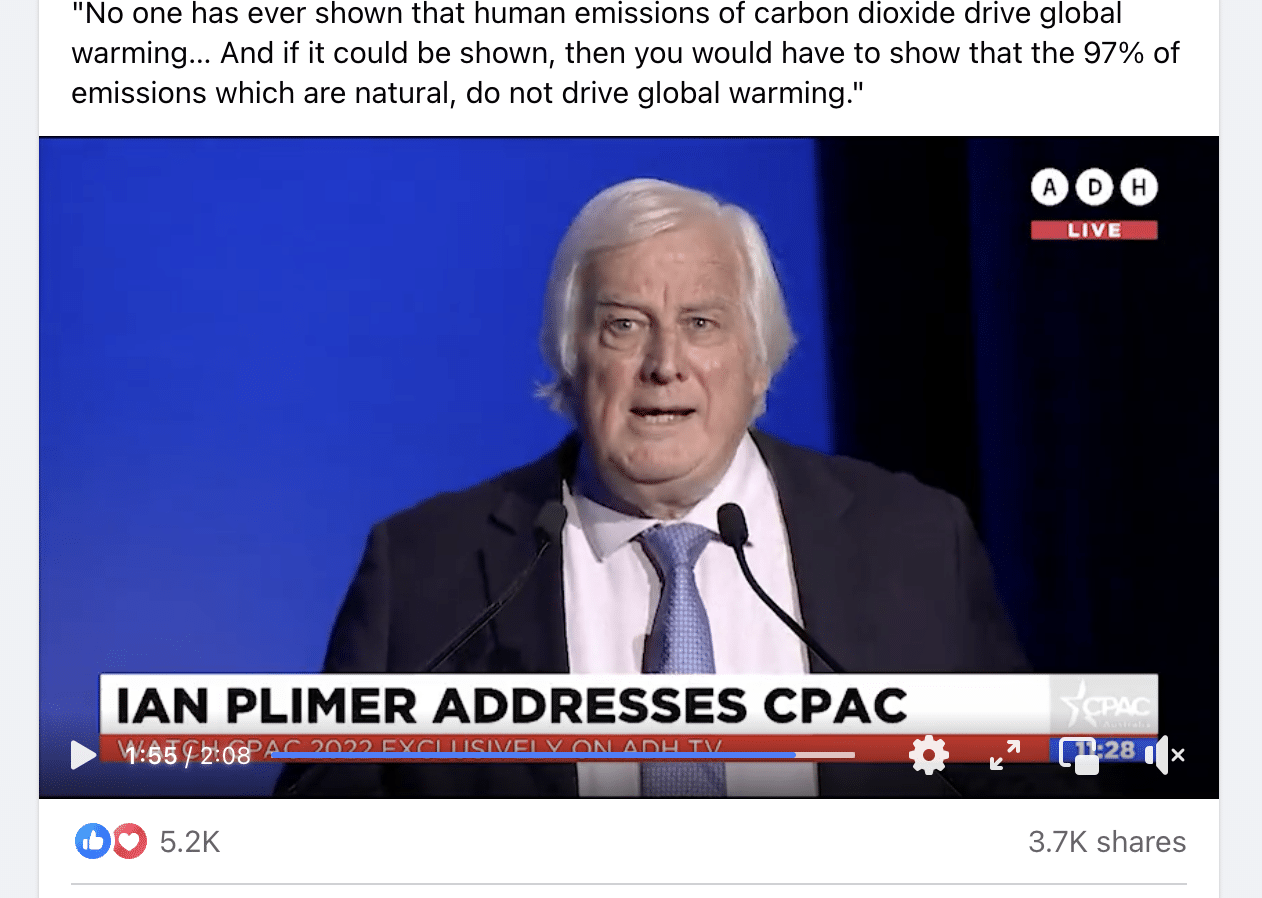- Climate
Video interview of Ian Plimer at Sky News falsely claims that a new study announces an incoming ice age, partly based on an incorrect Daily Mail headline
Reviewed content
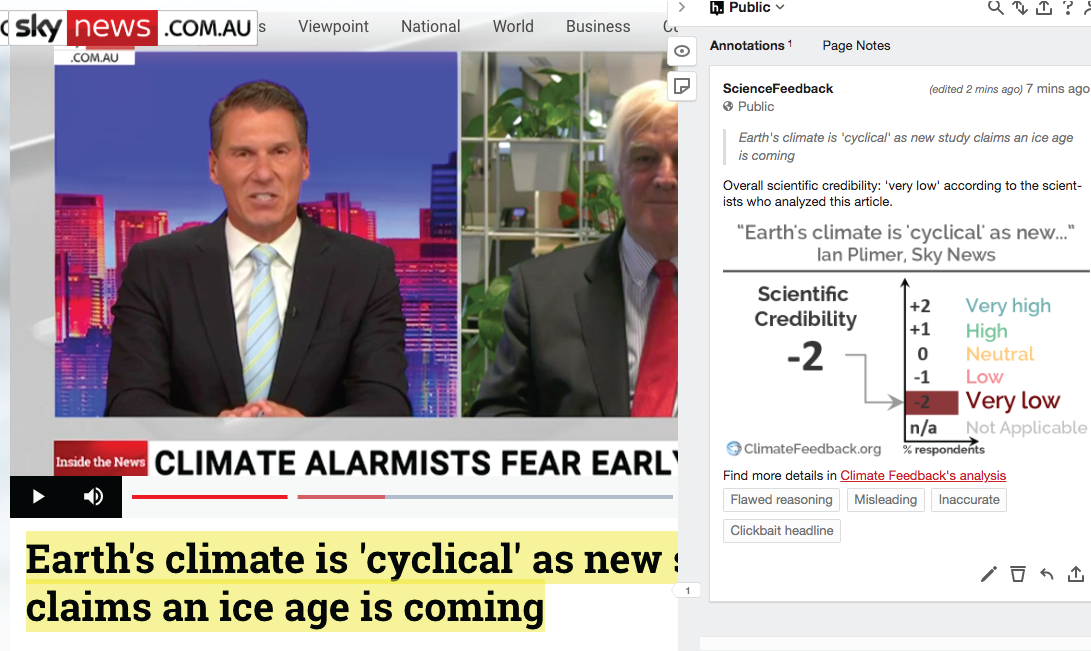
Headline: "“Earth's climate is 'cyclical' as new study claims an ice age is coming”"
Published in Sky News Australia, Daily Mail, by Ian Plimer, on 2021-01-13.
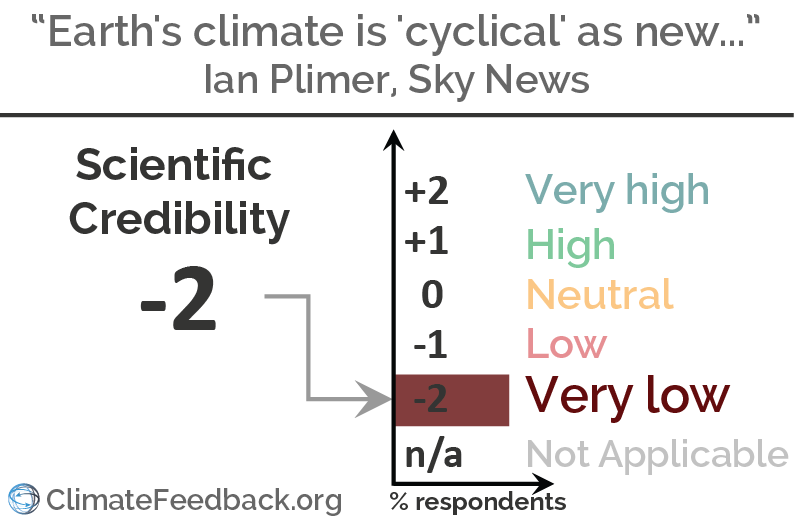
Summary
The video published by Sky News claims that “Earth’s climate is cyclical as new study claims an ice age is coming”, garnering more than 250 views in a few days. The video features Ian Plimer, who has repeatedly made false claims about climate change in the past. Scientists who reviewed this video found that it includes numerous inaccurate claims, misrepresents the findings of the study it discusses, and uses flawed reasoning that misleads viewers about the human-caused drivers of climate change.
Specifically, the video claims that “melting icebergs in the Antarctic could trigger a chain reaction that plunges Earth into a new ice age, scientists warn”. This claim also appeared as the headline of a Daily Mail article. This claim is inaccurate and misrepresents the results of the study it is based on. The study, which was recently published by Starr et al. in Nature, explores the sequence of events that occurred during glacial periods over the past 1.5 million years[1].
Ian Hall, a climate scientist at Cardiff University and author of the Nature study the claims are based on, told Climate Feedback, “This statement ignores the key finding from our study – we find that the climate systems response to Antarctic icebergs is highly sensitive to where they melt. We specifically describe the sequence of events which occurred during past interglacial to glacial conditions over the last 1.5 million years.”
Hall also explains that the results of this study cannot be extrapolated to current and future climate conditions. “Our paper is unambiguous and not relevant for modern/future climate change in this way, and reporting it as so is fundamentally misinterpreting our findings. Our study does not say or imply that an ice age is coming.”
The video and article headline take the results of the study out of context by neglecting to mention how the study focuses on past glacial periods and how current patterns of global warming might affect future patterns of Antarctic iceberg melt.
There are natural cycles of ice ages that occur over the span of 40,000 to 100,000 years and are linked to changes in Earth’s orbit around the Sun. However, these patterns don’t explain the recent trends in global warming caused by human-caused emissions of greenhouse gases. There are numerous scientific studies and several IPCC reports that all demonstrate how human-caused greenhouse gas emissions are driving global warming, contrary to the video’s claims[2-8].
UPDATE (22 Jan. 2021): The Daily Mail article corrected the headline and updated the introductory bullet points on 20 Jan. 2021. See the corrected article on archive.org.
Reviewers’ Overall Feedback
These comments are the overall assessment of scientists on the article, they are substantiated by their knowledge in the field and by the content of the analysis in the annotations on the article.

Research Scientist, University of Colorado, Boulder
This video is chock full of false and misleading information, and presented in a way to make the correct scientific information seem like a farce. For example, the direct link between human emissions of carbon dioxide and global warming is very well established[8]. The physics and chemistry of this link has been understood for well over 100 years, and science continues to affirm it. In another example, projections of the Earth’s future temperature – created through the efforts of thousands of scientists across the globe – show that the planet will continue to warm under all scenarios of continued emissions of heat-trapping gases. There will NOT be a sudden natural cooling over the coming centuries. Humans are warming the planet, and human actions will continue to be the primary control on future temperature trends for the Earth.

Assistant Research Professor, University of Minnesota
This fawning, biased interview with Sky’s favorite denier missed the point of the new paper about Antarctic iceberg and freshwater forcing on ocean circulation[1]. If they’d only read the Daily Mail article about this work, they’d see this statement: “Over the past three million years the Earth has regularly plunged into ice age conditions, but at present is currently situated within an interglacial period where temperatures are warmer. However, it may not happen again in the same way, due to the impact of human-created CO2 emissions warming the world.” For Plimer to think that human activities don’t affect planetary energy balance means he possesses arrogance that far eclipses his understanding of Earth’s climate system.

Research Associate, Harvard University
The starting point of the segment is an article in the Daily Mail, which mistakenly claims scientists are now warning of an incoming ice age, in a new study[1]. The study in question does no such thing, of course (which is actually clear if you read, not even the study, but the Daily Mail article itself), but the host and his guest, Ian Plimer, are not ones to care for such details and are all too happy to seize on this misleading, sensationalist headline to then deliver the usual mix of cherry-picked, out-of-context, and flatly wrong elements that have been addressed many times before, such as “climate has varied before”, “not unprecedented”, and “it’s the sun”.

Postdoctoral research fellow, Potsdam Institute for Climate Impact Research
In this video Cory Bernardi and well known climate science denier Ian Plimer deliberately misrepresent the findings of a recent article published by Starr et al. in Nature[1]. They imply that the mechanism proposed in the paper, ie., a reorganisation of the Atlantic Overturning cell due to changes in Antarctic iceberg-derived freshwater fluxes during glacial periods can somehow be applied to the present day and as a result, that a glacial period is imminent.
This is patently absurd – the described mechanism is one feedback in a series that are required for a glacial inception and cannot simply be applied in isolation to the present day climate in which we have dramatically increased concentrations of atmospheric CO2, a potent greenhouse gas.
Ian Plimer of course ignores this – claiming that climate is cyclical and that no one has ever proven anthropogenic CO2 to have driven global warming. Both claims have been extensively debunked here at Climate Feedback on previous occasions (see reviews here, here, and here), but to offer a brief refutation of the first point: The Earth’s climate is indeed cyclical over time-periods of multiple millennia and are driven primarily by the Earth’s orbital cycles. It is true that we are currently in a warm interglacial period and that up until the late 19th and early 20th Centuries, the world was gradually cooling again (see this figure by Ed Hawkins).
However, the magnitude of greenhouse gases we have emitted into the atmosphere and the rate at which we have done so has been sufficient to overpower this natural cycle and warm the Earth considerably.
Even with a slow down (which we have observed and even expect in a warming world)[9], or even shutdown of the Atlantic overturning circulation, this warming will continue as long as concentrations of greenhouse gases increase.

Physical Oceanographer, British Antarctic Survey
This video features a large number of incorrect statements. Many of these statements are myths that have been debunked again and again. In the video, Plimer and the anchor suggest that climate scientists in the 1970s predicted an ice age. This is not an accurate summary of scientific thinking in the 1970s. Peterson et al. (2008) showed that global warming was a prominent hypothesis in that decade[10].
They claim that “We are getting towards the end of a warm period. The peak of the warmth was about 5,000 years ago and we are heading to the next inevitable ice age.” There is no evidence for this claim. Plimer is essentially stating, without evidence, that the climate system will continue operating just as it has for hundreds of thousands of years. This statement ignores the fact that the climate system changes that we have already observed have the fingerprints of human activity all over it (e.g., the stratosphere is cooling, which is a characteristic pattern of global warming). You cannot explain recent warming since the 1850s without including human-driven carbon dioxide emissions.
They claim, “No one has ever shown that human emissions of carbon dioxide drive global warming.” This is a misleading statement that ignores the entire history of climate science. We have known since the time of the US Civil War (the UK Victorian Era) that carbon dioxide acts as a greenhouse gas. If more carbon dioxide is added to the atmosphere, then more energy will arrive at Earth’s surface. Adding energy to the climate system will change it; that extra energy does not simply vanish. Notably, we cannot explain warming since the 1970s using natural factors alone; we have to consider anthropogenic greenhouse gas emissions to explain this decadal scale warming.
Ian Plimer has strong connections to the Australian mining industry, which has a personal stake in preserving our current fossil-fuel heavy energy system. This was not disclosed during the interview, as Plimer was simply presented as a geologist.
In the interview, Plimer suggests that the Australian Bureau of Meteorology is only using relatively short records of the past few decades to understand climate change. This statement ignores how climate science operates. The scientists working at the bureau will also be familiar with the literature on long-term climate change; it is disingenuous to suggest that they somehow don’t have access to or an understanding of the data and literature on long-term climate cycles.
Plimer goes on an irrelevant rant about the education system, suggesting that anyone who disagrees with him is somehow poorly educated. This is an example of the “No true Scotsman” logical fallacy and is incorrect reasoning.

Professor of Atmospheric Sciences, University of Washington
It is old news (50+ years) that glacial cycles are due to changes in insolation (not CO2) that are due to variations in the orbit of the Earth around the Sun, and that these glacial cycles have time scales of 40,000 -100,000 years. Many of the statements in this video make it clear that the commentator (Plimer) does not understand the scientific article, which relates to a potential feedback that may operate in glacial cycles.
But the main thrust of the comments made in the interview concern whether changes in CO2 impact climate, whether humans are responsible for the increases in CO2, and the impacts of the increased CO2 on climate. The reviewer asks for 5 papers that show these links. I will simply note that the all 5 IPCC Assessment reports document the overwhelming evidence (thousands of peer reviewed papers) that: (i) CO2 is increasing due to burning of fossil fuels, that (ii) the warming of the planet seen since 1850 is much greater than can be explained by solar forcing, but it is entirely consistent with the warming expected due to the observed increase in CO2 and changes in atmospheric aerosols (also due to human activity).

Professor of Space Environment Physics, University of Reading
The idea of an ice age being triggered by global warming appears to be an extrapolation of what happened at the end of the last ice age in an interval called the Younger Dryas. As the world emerged from the last ice age it was pitched back into this further cold interval (named after a flower that thrived in the cold throughout Europe at the time). There have been a number of theories of its origin, of which some are now generally discounted, such as a comet impact. It is known that as the world warmed, a huge meltwater lake (Lake Agassiz) formed on the north American continent, the remnants of which today are the Great Lakes. A disruption of the Atlantic MOC (i.e. the Gulf stream) by the escaping cold, salt-free meltwater may have caused a temporary reverse in the global warming and a temporary return to ice age conditions[11]. Whatever the mechanism, it is thought such an event is likely to have been an inevitable consequence of the end of the glaciation[13]. As an analogy and predictor for what might happen because of present global warming, it is of no relevance whatsoever: the global warming involved in causing the Younger Dryas was that at the end of an ice age – the ice sheets that melted were vast and reached down to temperate latitudes (in the UK it reached Oxford!).
The video invokes solar changes as a cause of ice ages. This is wrong. They are intimately connected by changes in Earth’s orbit around the Sun – the so called “Milankovich cycles”[13,14]. These are indeed cycles and it is certainly true that Earth will return to another ice age. It is also true that another ice age is “due” in the sense that the present interglacial (warm period), the holocene, has been unusually long. The quip about it happening on a Tuesday hides the central fallacy here. The Milankovich cycles are extremely long and what is “due” on their timescales is far, far into the future even on the timescale of anthropogenic global climate change which has been centuries (but is now rapidly turning to decades).
The video says carbon dioxide rose at the start of ice ages. This is not true. We know well how the abundances of all atmospheric gases, including CO2, changed during ice ages from analysis of air bubbles in ice sheets and dating when that ice formed[15]. Carbon dioxide fell during the ice ages – not because it had any causative role in forming the ice age (as explained, above they are caused by changes in Earth’s orbital characteristics), rather, because colder water can store more carbon dioxide and because much carbon dioxide became locked into the ice and no longer took part in the carbon cycle exchanges between the atmosphere and the oceans and biosphere. We know this was a response and not a cause because the CO2 changes lag, not precede, the temperature changes.
Lastly, asking for 5 papers that show that anthropogenic carbon dioxide is causing global warming reveals a complete failure of understanding of the science – indeed of science in general. It is like asking for 5 papers that prove that a pain in your stomach, head or chest is due to cells on your body in which the cell division (which is part of the normal replacement and replication procedure in growth and repair) has gone into overdrive: in other words, what we refer to in a shorthand as a cancer. Our knowledge of cancer and its causes does not rest on 5 papers, nor can it be summed up in 5 papers. It rests on thousands and thousands of papers which cancer experts knit together into a coherent understanding. It is exactly the same with climate change science.
Annotations
The statements quoted below are from the article; comments are from the reviewers (and are lightly edited for clarity).
“Cardiff University has released a study on the ice ages, It claims that icebergs melting in the Antarctic may actually trigger a reaction that plunges Earth into an ice age.”

Professor, Cardiff University
This statement ignores the key finding from our study – we find that the climate systems response to Antarctic icebergs is highly sensitive to where they melt. We specifically describe the sequence of events which occurred during past interglacial to glacial conditions over the last 1.5 million years.

Research Associate, Harvard University
The authors of the study did not say that – as the Daily Mail notes itself. Paleoclimate scientists understand that the cyclical ice ages of the last million years or so are linked to small, cyclical changes in the Earth’s orbit, but the exact mechanistic details are not fully understood: the new Nature paper that the Daily Mail reports on, suggests a role for changes in the spatial patterns of iceberg melt in the inception of past ice ages. It doesn’t say current melt is going to trigger a new ice age: as the Daily Mail itself writes, “The impact of human-created CO2 emissions could make the Southern Ocean too warm for Antarctic icebergs to reach, bringing an end to this 1.6 million year cycle of ice ages starting with melting icebergs, study authors warned.” So, kind of the opposite actually. So the article headline is plain wrong, and so is the premise of the Sky News segment.
“But I thought alarmists were telling us that our approach to climate was leading us into believing that we’re the direct cause of global warming and we’re all going to boil and now we’re saying the ice age is coming again.”

Professor, Cardiff University
Our paper is unambiguous and not relevant for modern/future climate change in this way, and reporting it as so is fundamentally misinterpreting our findings. In fact, in the press release for the study, we emphasise that our findings are specifically related to natural “Milankovitch” cycles in orbital forcing, however with current human greenhouse-gas emissions and increasing global temperatures, the Southern Ocean is likely too warm for icebergs to be transported as described in the paper and melt in the regions necessary for the chain of events we highlight to be triggered. Our study does not say or imply that an ice age is coming. It does emphasise the importance of understanding iceberg trajectories and melt patterns in developing the most robust predictions of their future impact on ocean circulation and climate.
“What’s going on is cycles – we’re getting towards the end of a warm period, the peak of the warmth was about 5000 years ago, and we are heading for the next
inevitable ice age.”

Professor, Cardiff University
“What’s going on is cycles” is at least a reference to our paper. However, the paper does not deal with modern (post-industrial) climate timescales. The statement by Ian Plimer is not supported by the majority of scientific evidence regarding the duration of the ‘present interglacial’. Plimer here is lacking an understanding of the concept of thresholds. It is well established that the onset of a glacial period has only ever, and can only ever, occur when atmospheric CO2 is below a certain threshold. When atmospheric CO2 concentration is too high, the orbital forcing which favours an ice age is simply not enough to cause an ice age. For example, a study by Archer and Ganapolski (2005) found that no glacial inception will occur with atmospheric CO2 concentrations above 400 ppm[16]. Tzedakis et al. (2012) go on to show that under the current orbital configuration, a CO2 concentration of below pre-industrial levels would be required for an ice age to begin[17]. Hypothetically, if atmospheric CO2 was lower than around 240 ppm, we might have seen the inception of an ice age develop at some point over the coming several millennia. However, as we approach atmospheric CO2 concentrations of double this, caused by human greenhouse-gas emissions, the scientific consensus is clear: we are not currently heading for an ice age.
Regarding the “5000 year cooling trend” alluded to by Plimer, it is important to recognise that this is still an active area of research. Whether the Holocene was characterised by a long-term cooling or warming trend is a more complex question than this comment suggests. It is in fact likely that different temperature trends prevailed over different regions[18]. Whilst Holocene climate variability is an interesting exercise in our understanding of the climate system, it is important to remember that regardless of whether there was a long-term cooling or warming trend over the Holocene, the warming we have experienced since the industrial era is unprecedented in its rate – this is not part of some long-term trend, it is very clearly an anthropogenic perturbation of the climate system.

Research Associate, Harvard University
It’s true that we are in an interglacial period, the Holocene, which, prior to the abrupt warming of the past century, had been warmest around 6000 years ago, as far as paleo-climate scientists can reconstruct. However, owing to recent man-made warming, there’s every indication that current temperatures are now on par with the warmest temperatures of even that period[19], and they will continue to increase because of greenhouse gas emissions, to a level (for instance, +3 degrees compared to pre-industrial temperatures) probably not seen in the last couple million years. So we are not headed into an ice age any time soon.
In fact, a study in Nature showed that, even without man-made CO2 emissions and warming, the next orbitally-driven ice age would probably not have happened before another 50,000 years (which is a bit unusually long)[20]; and given current man-made warming, now it won’t happen for another 100,000 years[19,20].
“We’ve had 6 major ice ages, during which we’ve had glaciations and warmer periods – all of that happened before humans were on planet earth.”

Professor, Cardiff University
It is not clear where Plimer got the number 6 from here. Using a conservative definition of an ice age, there have been at least 10 in the last 1 million years, with over 50 since the development of a substantial northern hemisphere ice sheet[21].

Assistant Research Professor, University of Minnesota
Causes of past climate fluctuations are relatively well understood, paced by slight changes in Earth’s orbit around the sun (Milankovitch cycles). That human emissions of greenhouse gases are currently trapping heat and warming the planet is accepted fact. Our activities now exert more control on Earth’s climate than orbital variations, and will override any coming ice age based on orbitally-induced decreases in the amount of incoming solar radiation.
“Every single major ice age started when we had more CO2 in the atmosphere than now.”

Professor, Cardiff University
Again, it is not clear where this claim comes from, it is simply not supported by any existing records of atmospheric CO2 over the Pleistocene[22,23]. The highest CO2 concentration recorded in ice core records (0 – 800 thousand years ago) is around 300 ppm[22]; the highest Pleistocene CO2 reconstructed using geochemical proxies (boron isotopes) is similar, around 300ppm[23]. Indeed, over the past 23 million years, CO2 has never reached atmospheric concentrations as high as today, maxing out at around 350 ppm during the mid-Miocene[24].
“No-one has ever shown that human emissions of carbon dioxide drive global warming. If you think it has been shown, please give me the 5 scientific papers that show
this.”

Professor, Cardiff University
Among the vast scientific literature on this topic, the following 5 papers are a good starting point:
How do we know that the increased atmospheric CO2 concentrations are from humans burning
fossil fuels? The Suess effect[2,3]. How do we know that this CO2 drives global warming? Our understanding of the physics of radiative forcing date back at least to the work of Svente Arrhenius (1859 – 1927). This is not a contentious topic in the modelling of Earth’s climate system. From the simple to the sophisticated, our models of the climate system are unequivocal[4], as are the geological data[5,6].

Research Associate, Harvard University
This rhetorical and, frankly, absurd point by Ian Plimer (and others) has been addressed before in other reviews. Yes, there is no one silver bullet argument, but multiple lines of evidence. In a way it’s a akin to a murder trial: sure, there is no one videotape absolutely “proving” that CO2 killed the victim, but we know CO2 was there, had the means and the motive (it’s a greenhouse gas), there’s even partial eye witness account (showing the increase in greenhouse effect in observations)[7], there is DNA evidence (~climate modeling shows CO2 explains the warming well) and all the other possible suspects (sun, volcanoes, etc) have solid alibis. So the case has been solved for a while now[7].

Assistant Research Professor, University of Minnesota
This is an easily verified falsehood. Plimer should be aware of work by Australian colleagues at the Commonwealth Science and Industrial and Research Organization (CSIRO) that shows how carbon dioxide emissions have rapidly increased in the last 150 years, using Antarctic ice and bubbles of old air trapped inside (locked in as snowflakes trap air between their fingers and are buried). The Law Dome research site in Antarctica is a keystone in our understanding of the atmospheric carbon budget going back the last 2000 years. I was a leader of the most recent scientific expedition to this important location, and can verify that the work of Plimer’s fellow Australian’s at this site is world class (see here). Not only is a ~40% increase in carbon dioxide observed in the last 150 years, but the stable isotope of carbon, 13-C has declined over that period. That definitively indicates that the carbon dioxide being emitted comes from a source depleted in 13-C, which provides clear evidence for attribution of industrial period carbon dioxide variations to human activity (fossil fuel hydrocarbons are depleted in 13-C). See figure 6 of Rubino et al., 2013 below[25].
“People have very little outdoor experience…We have a city-based population that doesn’t read the scientific literature, that has had no life experience.”

Assistant Research Professor, University of Minnesota
Plimer goes on to make absurd arguments based on common cultural tropes and lines of division, suggesting that those living in cities and having “very little outdoor experience.” This has nothing to do with one’s understanding and experience of climate and has no relevance to the science of climate change and the unprecedented warmth that Australia’s Bureau of Meteorology reports year after year. Given our understanding of the factors at play, it is clear that human emissions of greenhouse gases is trapping excess heat in the atmosphere, causing warming that is particularly impacting Australia by way of extreme drought and severe fires. Australia’s temperature has been rapidly rising since this new anthropogenic warming emerged in the last ~century. The climate of the deep past is immaterial here, as this time is not analogous to the working of Earth’s climate system today, as any geologist would know if they were properly educated at a modern, degree-granting institution of higher education.
“Most of [the cycles in climate] are driven by… the sun.”

Assistant Research Professor, University of Minnesota
This is again, easily disproven. Solar variability does not exert warming that matches observed temperature increases. See US National Climate Assessment 4, Figure 2.1 below.
REFERENCES:
- 1 – Starr et al. (2021) Antarctic icebergs reorganize ocean circulation during Pleistocene glacials. Nature.
- 2 – Keeling (1979). The Suess effect: 13Carbon-14Carbon interrelations. Environment International.
- 3 – Eide et al. (2017). A global estimate of the full oceanic 13C Suess effect since the preindustrial. Global Biogeochemical Cycles.
- 4 – Meehl et al. (2020). Context for interpreting equilibrium climate sensitivity and transient climate response from the CMIP6 Earth system models. Science Advances.
- 5 – Shakun et al. (2012). Global warming preceded by increasing carbon dioxide concentrations during the last deglaciation. Nature.
- 6 – (2011) Climate past and future. Nature Geosciences.
- 7 – Feldman et al. (2015). Observational determination of surface radiative forcing by CO2 from 2000 to 2010. Nature.
- 8 – IPCC (2014) Climate Change 2014: Summary for Policymakers. Contribution of Working Groups I, II and III to the Fifth Assessment Report of the Intergovernmental Panel on Climate Change.
- 9 – Caeser et al. Observed fingerprint of a weakening Atlantic Ocean overturning circulation. Nature.
- 10 – Peterson et al. (2008) The myth of the 1970s global cooling scientific consensus. Bulletin of the American Meteorological Society.
- 11 – Keigwin et al. (2018) Deglacial floods in the Beaufort Sea preceded Younger Dryas cooling. Nature Geoscience.
- 12 – Broecker et al. (2010) Putting the Younger Dryas cold event into context. Quaternary Science Reviews.
- 13 – Huybers et al. (2006) Links between annual, Milankovitch and continuum temperature variability. Nature.
- 14 – Markonis et al. (2013) Climatic Variability Over Time Scales Spanning Nine Orders of Magnitude: Connecting Milankovitch Cycles with Hurst–Kolmogorov Dynamics. Surveys in Geophysics.
- 15 – Sigman et al. (2000) Glacial/interglacial variations in atmospheric carbon dioxide. Nature.
- 16 – Archer et al. (2005). A movable trigger: Fossil fuel CO2 and the onset of the next glaciation. Geochemistry, Geophysics, Geosystems.
- 17 – Tzedakis et al. (2012). Determining the natural length of the current interglacial. Nature Geoscience.
- 18 – Bader et al. (2020). Global temperature modes shed light on the Holocene temperature conundrum. Nature Communications.
- 19 – Kaufman et al. (2020). Holocene global mean surface temperature, a multi-method reconstruction approach. Scientific Data.
- 20 – Ganopolski et al. (2016). Critical insolation–CO 2 relation for diagnosing past and future glacial inception. Nature.
- 21 – Lisiecki et al. (2005). A Pliocene‐Pleistocene stack of 57 globally distributed benthic δ18O records. Paleoceanography.
- 22 – Petit et al. (1999). Climate and atmospheric history of the past 420,000 years from the Vostok ice core, Antarctica. Nature.
- 23 – Hönisch et al. (2009). Atmospheric carbon dioxide concentration across the mid-Pleistocene transition. Science.
- 24 – Cui et al. (2020). A 23 m.y. record of low atmospheric CO2. Geology.
- 25 – Rubino et al. (2013) A revised 1000 year atmospheric δ13C‐CO2 record from Law Dome and South Pole, Antarctica. Journal of Geophysical Research: Atmospheres.

